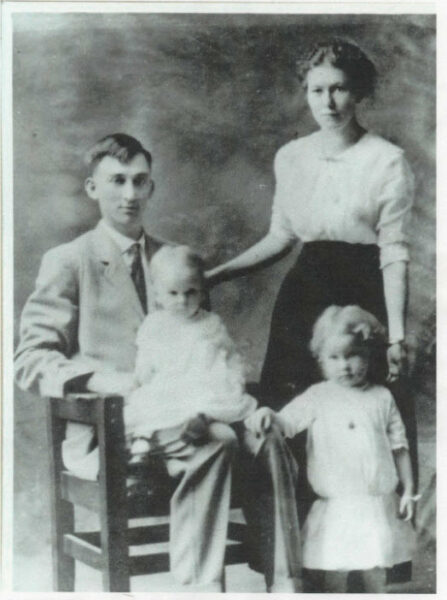-
Place of Birth
Columbus, Indiana, US
-
Place of Death
Indianapolis, Indiana, US
-
Burial Place
Garland Brook Cemetery, Columbus, Indiana, US
Meet John Edward Beyl
Before he became a bakery foreman, a father of five, and (unintentionally) a source of frustration for modern researchers, John Edward Beyl was just a boy growing up on Jackson Street in Columbus, Indiana.
He was born on a chilly February day in 1887, according to his death certificate, to Jacob Beyl and Mary E. Kern – though some records name his mother as Margaret E. (more on that puzzle later). While the name “John” wasn’t included on his birth listing – and the last name was charmingly butchered – the Bartholomew County, Indiana, Birth Index still pointed me in the right direction. Classic genealogy move: you’re lucky to get 80% accuracy and a prayer

Confirmed sources: Federal Census records, Indiana Select Marriages Index, WWI Draft Card, Social Security Death Index, and a suspicious amount of coffee.
The 1900 Census: Life on Jackson Street
In 1900, 13-year-old John (or just “Edward,” as some documents begin to call him) lived at 228 Jackson, Columbus Township, with his parents and siblings. His father, Jacob, 53, had immigrated from France in 1852, worked as a carpenter, and was renting the home.
She possibly went by both names, or perhaps Jacob remarried, and the paper trail just got messy. Either way, I’m flagging it for further review.
If I find a smoking baptismal record in the attic someday, you’ll be the first to know.
His mother, Margaret E., born in Indiana to German parents, was raising a bustling household of at least five children – and had already buried two by then.

Their home included:
- Jacob W., 24 – a carpenter like his father
- Mary E., 20
- Lillie F., 10
- Thomas, 7
- And a baby granddaughter, Hellen M. Bond, just 11 months old
John was still in school then, and likely just starting to glimpse adulthood – though, as we’ll see, it came fast.

A Man Called Edward – The Beyl Years After 1900
By the time the new century had settled in, John Edward Beyl—though known increasingly by his middle name, Edward—was moving steadily into manhood. While the world thundered forward with industry and change, Edward’s life unfolded within the humbler rhythms of a working-class American town.
🏠 1910 — Life on Jackson Street
In 1910, Edward was still living with his parents, Jacob and Margaret Beyl, in Columbus, Indiana. Now 23, he was no longer a schoolboy, but a working man—though the term “working” proved a bit generous that year. The census revealed that Edward had been unemployed for 20 weeks. He and his brother Jacob Jr. were both listed as laborers at a liquor factory, though whether they were bottling spirits or mopping floors remains a mystery lost to time.

The Beyl family rented a modest home at 542 Jackson Street, and their youngest son, Grover T. Beyl, now 17, worked at a furniture plant. Their parents were aging; Jacob Sr., 63, had retired from carpentry, while Margaret, 53, had also been out of work for months after a stint at a poultry house. Times were not easy, but the Beyls were a tenacious bunch.

💍 1911 — A New Chapter Begins
On August 24, 1911, Edward married Edna Mae Applegate in Marion County, Indiana. He was 24; she was just 16. The marriage was the beginning of a life filled with both hope and hardship, and as their family grew, so did the weight of responsibility on Edward’s narrow, work-worn shoulders.

👶 1913–1914 — Daughters and Dust
By 1914, the couple had welcomed two daughters, Margaret L. and Viola Mildred, born just over a year apart. Edward was barely into his late twenties and already the father of two small children. The family remained close to home, with Columbus and Indianapolis marking their movements through city directories and census records.
🪖 1917 — The Great War Calls
Like so many young men of his generation, Edward registered for the World War I draft on June 5, 1917. At the time, he lived at 540 Jackson Street in Columbus and worked as a Wood Assembler at the Emerson-Brantingham Company, a farm machinery manufacturer. He listed a wife and three children as dependents and claimed exemption from service on the basis of their need for his support.
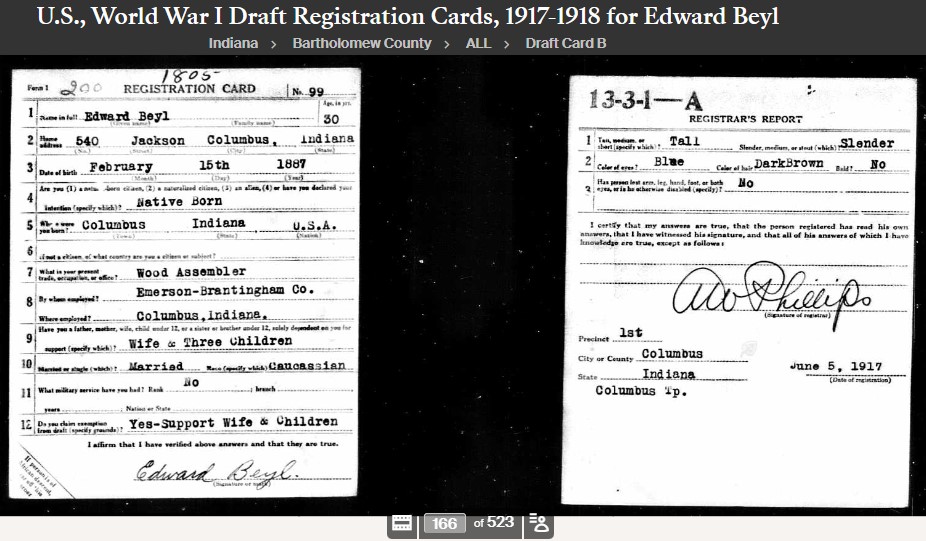
Tall and slender with dark brown hair and blue eyes, Edward must have cut a striking figure, even in factory overalls. But his eyes, perhaps, told the story of a man who carried more burdens than dreams.
🍞 1920s — A Foreman with Flour on His Sleeves
The 1920 census found the Beyl family relocated to 848 Prospect Street in Indianapolis. Edward, now 31, was employed as a Bakery Foreman. It was a respectable position in a rapidly industrializing city—an indicator of his reliability and work ethic.

By now, Margaret L., Viola, and Charles had joined the household. The census curiously noted that Edward’s native tongue was French, a nod to his father Jacob’s Alsatian roots. But English, industry, and family survival were the languages of Edward’s daily life.
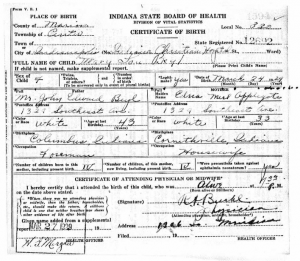
In 1929, at age 43, Edward and Edna welcomed their youngest daughter, Mary Lou, into the world. She was born at Indiana Christian Hospital, and the family lived at 1329 Southeast Avenue. Edward was listed simply as a Foreman, a role with responsibility but likely little rest.
🗂️ 1930s — The Great Depression and a Life in Motion
By the 1930 Census, the family had moved again—now living at 1329 East Street in Indianapolis. Edward was working as a Dispenser at a Bakery Company. Their children were growing fast—Margaret had become a saleslady at a dry goods store, and the household seemed full of life.
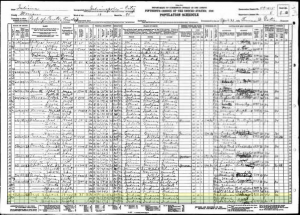
City directories from 1931 and 1933 show Edward and Edna hopping addresses: 329 S. Baet Street, then 221 Naomi. By this point, both Margaret and Mildred had returned home, possibly due to the economic strains of the Depression.

Edward had shifted roles again, listed as a Warehouseman and then simply as a Baker—a man doing whatever he could to keep the lights on and mouths fed.

🧳 1940 — A Laborer’s Legacy
In 1940, at age 53, Edward was listed in the census as a Laborer in Flood Prevention. The family lived at 1020 S. New Jersey Street, and he earned a modest $453 for the year. His son Charles, still in school, contributed $200 through NYA work—a New Deal program designed to keep America’s youth out of the breadlines.
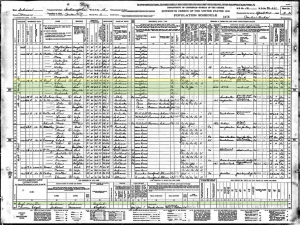
There’s a poignancy to these numbers—a life of hard labor, modest reward, and quiet endurance.
📋 1942 — One Last Draft
Edward registered for the World War II draft at age 55. Still living on New Jersey Street, he listed Charles Beyl as his emergency contact. He was employed by WFA, located at 19 W. South Street. Curiously, he misstated his birth date—perhaps an honest mistake, or perhaps, after all these years, the details of his own life had begun to blur in the daily grind.
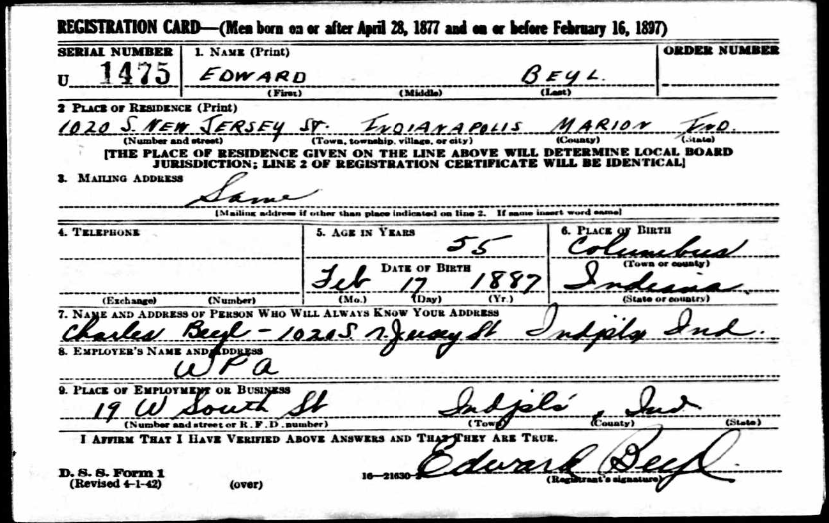
⚰️ 1949–1966 — Final Days and Rest
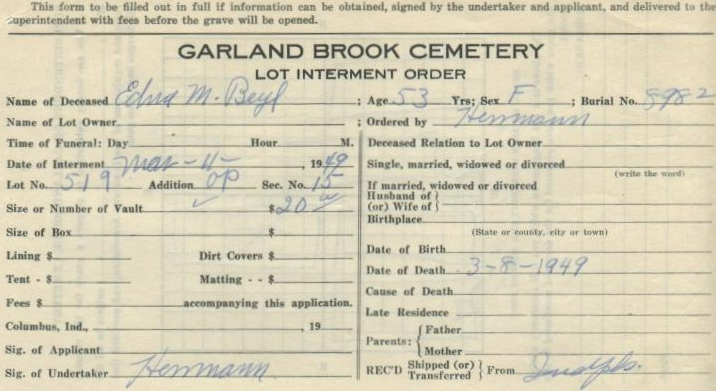
On March 8, 1949, Edna Mae passed away at age 53 and was buried in Garland Brook Cemetery, Columbus, Indiana. Edward lived on for another 17 years, eventually working as an Elevator Operator at the U.S. Rubber Company—a job befitting a man who had spent his life lifting others.
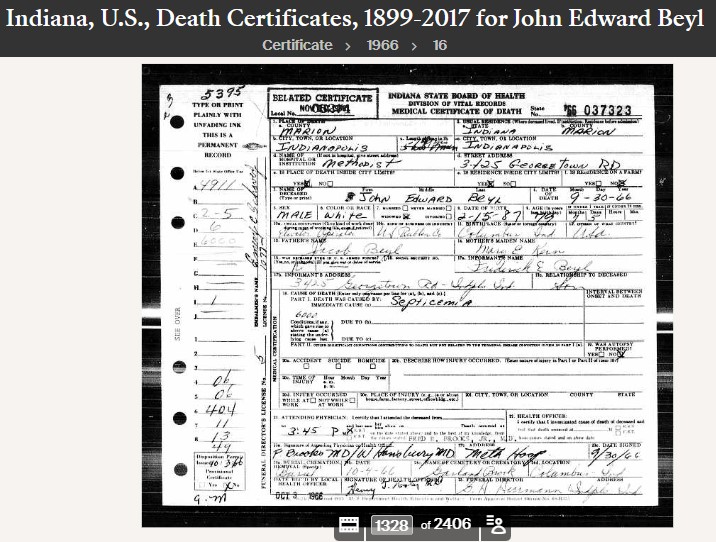
He passed away on September 30, 1966, at age 79, from Septicemia. His youngest son, Frederick, signed the death certificate. No autopsy was performed. Edward was laid to rest beside his beloved Edna, closing the long, steady story of a man who asked for little but gave his all.
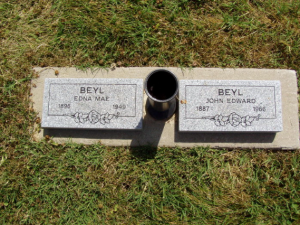
John was buried at Garland Brook Cemetery in Columbus, Indiana, on 4 October 1966, next to his wife.
That’s all for now, I’ll check back regularly and update this page as I find additional information.
💬 Want to share a memory, ask a question, or join the conversation?
John Edward Beyl’s Intro Page is now open for comments! Head over there to leave your thoughts, theories, or family lore:
👉 Visit the Intro Page →
I’ll leave you with a common Genealogy phrase:
When we die we become ‘stories’ in the minds of other people.
Happy story finding!
~Kris
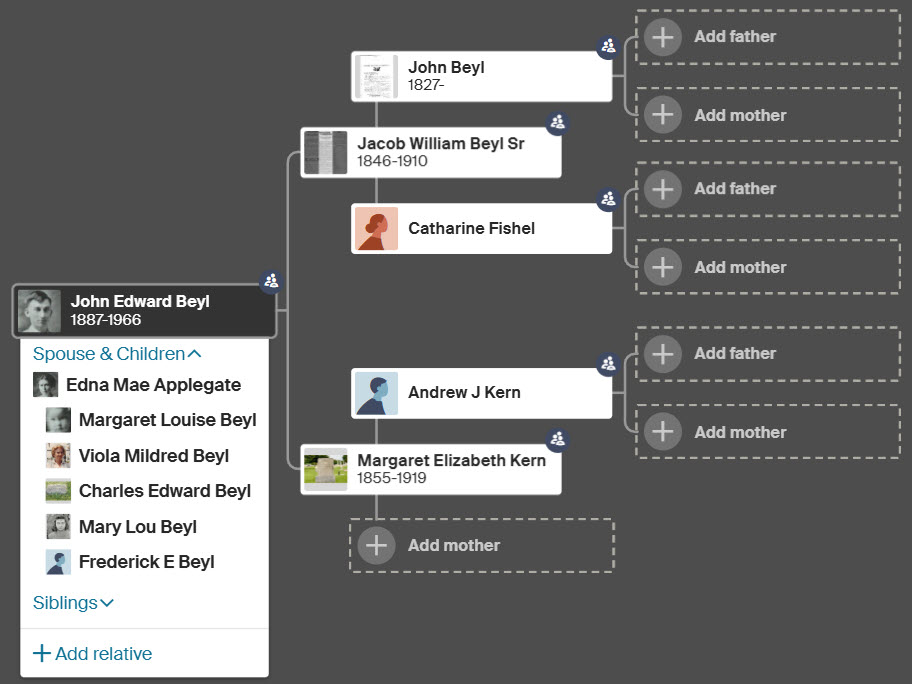
 This post first appeared on the original version of the site.
This post first appeared on the original version of the site.
I’ve resurrected it here – because it’s still got teeth!
Originally published March 10, 2017.
Last updated July 9, 2025, with new sources + AI strategies.


